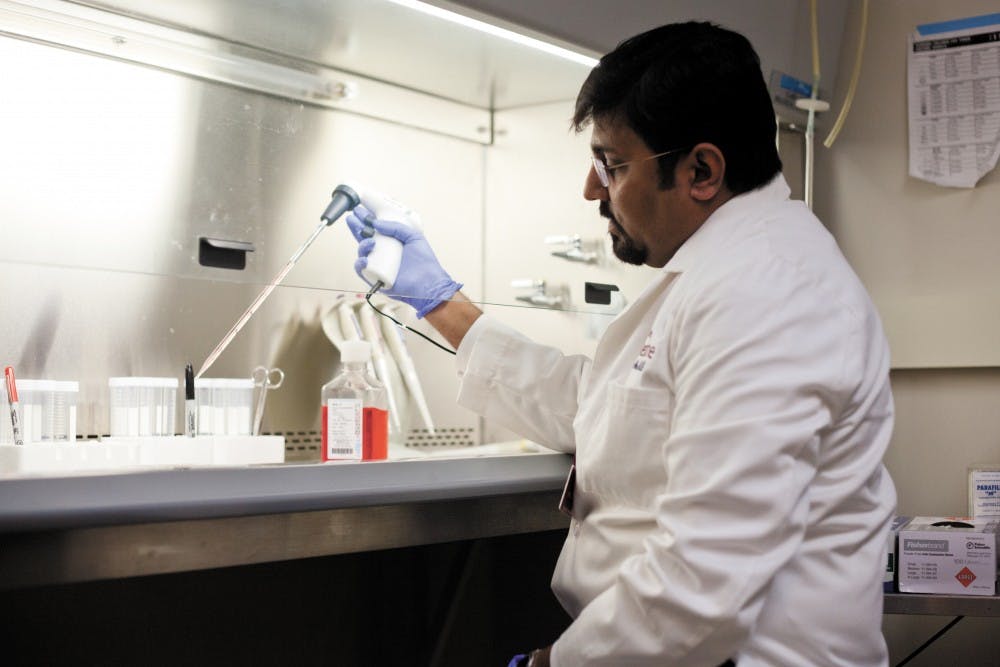Researching risks

Dr. Neeraj Vij uses a pipette to transfer liquid during an experiment at his lab Feb. 4, 2015 in one of CMED’s research buildings.
A ¨safe alternative¨ to smoking cigarettes is being tested at Central Michigan University.
Neeraj Vij, an associate professor of molecular and cell biology, is conducting research with students and fellows ion the effects of cigarettes, electronic cigarettes and secondhand smoke.
"Electronic cigarettes impact protein processing which causes programmed cell death," Vij said.
Vij and his team exposed five mice to vapors from an electronic cigarette. The mice inhale the vapors for extended periods. Molecular mechanism in the mice are studied to trace any causes of lung disease.
Electronic cigarettes are a safety hazard for children, Vij said. He has submitted an abstract on the actual health effects of using e-cigarettes and is awaiting publication in March. It is important to educate parents on the potential risk of leaving e-cigarettes unattended in their homes.
¨There is no safety cap which makes it easy for children to get a hold of," he said. ¨There has been a recent accidental death of a 1-year-old child in the U.S. We're pushing companies to create child-proof packaging to avoid this. Federal legislation to pass regulations is currently pending in both the House and the Senate."
The primary focus of Vij's laboratory is to identify "the physical process" associated with lung disease or injury. His lab also concentrates on the identification of therapeutic strategies for chronic obstructive lung diseases.
One of two main goals of Vij's research is to show the dangers of secondhand cigarette smoke.
"The concern is with children getting exposed to secondhand smoke," Vij said. "This can be car exposure, same room exposure and smoke extracts from fingers. All of this exposure can incite emphysema."
Vij's goal to limit secondhand smoke has already spread on campus. He worked with other university leaders to make CMU a smoke-free campus in order for his research to qualify for specific grants for CMED.
"The focus of my lab is working on respiratory disease, I'm specifically interested in chronic obstructive lung diseases which include Cystic Fibrosis and COPD-emphysema," Vij said. ¨The whole idea is to understand the disease in people and how these molecular mechanisms and pathways get modified during a particular disease state.¨
Vij works with six CMU students—four from the biology department and two from CMED—and Indian post doctoral fellow, Prashanth Chandarmani. The group uses a combination of models to research the development of lung disease.
One model is in-vitro systems, cell cultures that grow on plates. Another is murine model where different molecular mechanisms induce levels of genes in disease, and are studied at a molecular level.
"We have a machine in the lab that is used to model human disease by providing cigarette smoke to mice in a chamber in order for them to develop emphysema," Vij said.
Vij is frequently invited to serve as a reviewer for various Journals and grant review study sections. His own research has been funded by the National Institute of Health, Flight Attendant Medical Research Institute, John Hopkins University and external funding. Vij also has several pending grants through CMU.
"We really want to make a difference with what we do in this lab. We want to translate our research to the people," Vij said. "There is a need to study the effects of smoking and to identify the molecular causes of lung disease and how to control it."
Vij has also trained and educated students and research fellows leading to placements at top-tier universities, medical schools or industries. Linden senior Colin Westphal began working with Vij in the summer.
"I did this mostly based on furthering my medical research," Westphal said. "I was also interested in aging in relation to COPD (emphysema).¨



